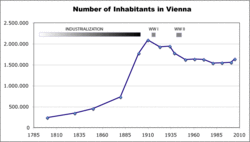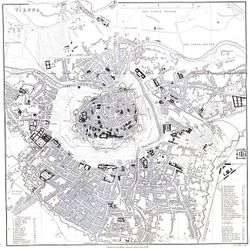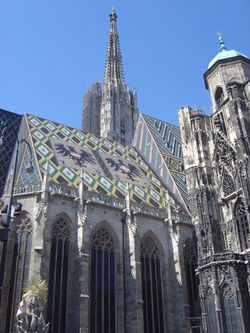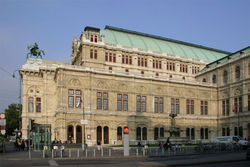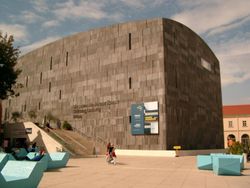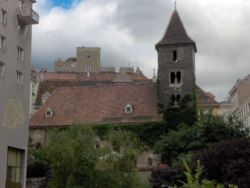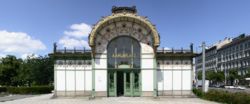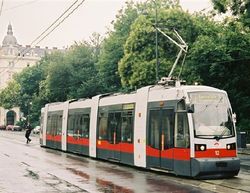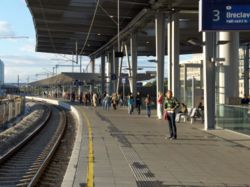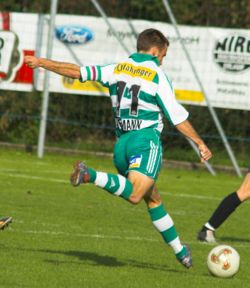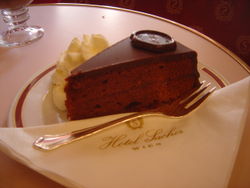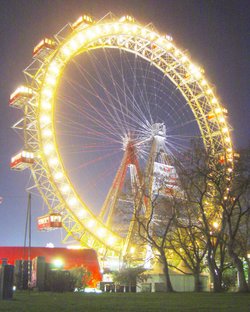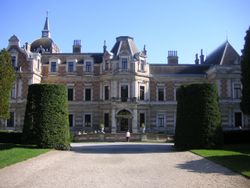Vienna
2007 Schools Wikipedia Selection. Related subjects: European Geography
| State Coat of Arms | |
|---|---|
 |
|
| General Information | |
| Country: | Austria |
| State Capital: | Vienna |
| ISO 3166-2: | AT-9 |
| Vehicle Registration: | W |
| Community Identification Number: | 90101 - 92301 |
| Postal codes: | 1010 - 1239, 1400, 1450 |
| Area code: | 01 |
| Homepage: | www.wien.gv.at |
| State Flag of Vienna | |
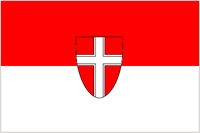 |
|
| Map: Vienna in Austria | |
 |
|
| Name in other languages | |
| German | Wien |
| See "Vienna" in other languages | |
| Politics | |
| Mayor and governor | Michael Häupl ( SPÖ) |
| Governing Party | SPÖ |
| Seats in the Municipal Council (100 seats): |
SPÖ 55 ÖVP 18 Greens 14 FPÖ 13 |
| Last Election: | 23 October 2005 |
| Next Election: | October 2010 |
| Population | |
| Population: | 1,651,437 (31.12.2005) 2,165,357 metro area |
| Population density: | 3,931.3/km² |
| Geography | |
| Area: | 414.90 km² |
| - percent land: | 395.51 km² (95,33%) |
| - percent water: | 19.39 km² (4,67%) |
| Location: | |
| Dimensions: | North-South: 22.4 km East-West: 29.2 km |
| Highest Point: | 543 m ( Hermannskogel) |
| Lowest Point: | 151 m ( Lobau) |
| Administrative Structure | |
| Districts: | 1 Statutarstadt 23 Bezirke |
| Map: Districts of Vienna | |
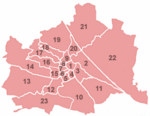 |
|
Vienna (German: Wien [viːn]) is the capital of Austria, and also one of the nine States of Austria. Vienna is Austria's primate city; with a population of about 1.6 million (2.2 million within the metro area), Vienna is by far the largest city in Austria as well as its cultural, economic and political centre. Vienna lies in the south-eastern corner of Central Europe and is close to the Czech Republic, Slovakia and Hungary. In 2001, the city centre was designated a UNESCO World Heritage Site .
History
Founded around 500 BC, Vienna was originally a Celtic settlement. In 15 BC, Vienna became a Roman frontier city ("Vindobona") guarding the Roman Empire against Germanic tribes to the north.
During the Middle Ages, Vienna was home of the Babenberg Dynasty and in 1440 became residence city of the Habsburg dynasties from where Vienna eventually grew to become the secret capital of the Holy Roman Empire and a cultural centre for arts and science, music and fine cuisine. The Ottoman invasions of Europe in the 16th and 17th centuries were stopped twice just outside Vienna (see Siege of Vienna, 1529 and Battle of Vienna, 1683).
In 1805, Vienna became capital of the Austrian Empire — the later Austro-Hungarian Empire — and played a major role in European and World politics, including hosting the 1815 Congress of Vienna. In 1918, after World War I, Vienna became capital of the First Austrian Republic. Between 1938 (Anschluß) and the end of the Second World War, Vienna lost its status as a capital to Berlin. After 1945, Vienna was divided into four zones by the Allies and became a hot-bed for international espionage between the Western and Eastern blocs.
Historical population
Due to industrialisation and immigration from other parts of the Empire, the population of Vienna increased sharply during its time as capital of Austria-Hungary ( 1867- 1918). However, after World War I, many Czechs and Hungarians returned to their ancestral countries, resultin in a decline in the Viennese population. At the height of the immigration, about one third of the people living in Vienna were of Slavic or Hungarian descent.
By 2001, only 16% of people living in Vienna had nationalities other than Austrian, nearly half of which were from the former Yugoslavia; the next most numerous nationalities in Vienna were Turkish (39,000 or 2.5%), Polish (13,600 or 0.9%) and German (12,700 or 0.8%) .
Subdivision
Vienna is composed of 23 districts (Bezirke). Legally, they are not districts in the sense of administrative bodies with explicit powers (such as the districts in the other Austrian states), but mere subdivisions of the city administration. Elections on the district level give the representatives of the districts some political power in fields such as planning and traffic.
The 23 districts are numbered for convenience in a roughly clockwise fashion starting in the city centre: 1. Innere Stadt, 2. Leopoldstadt, 3. Landstraße, 4. Wieden, 5. Margareten, 6. Mariahilf, 7. Neubau, 8. Josefstadt, 9. Alsergrund, 10. Favoriten, 11. Simmering, 12. Meidling, 13. Hietzing, 14. Penzing, 15. Rudolfsheim-Fünfhaus, 16. Ottakring, 17. Hernals, 18. Währing, 19. Döbling, 20. Brigittenau, 21. Floridsdorf, 22. Donaustadt, 23. Liesing.
The heart and historical city of Vienna, the Innere Stadt, was once surrounded by walls and open fields in order to deny cover to potential attackers. The walls were razed in 1857, making it possible for the city to expand and eventually merge with the surrounding villages. In their place, a broad boulevard called the Ringstraße was built, along which imposing public and private buildings, monuments, and parks now lie. These buildings include the Rathaus (town hall), the Burgtheater, the University, the Parliament, the twin museums of natural history and fine art, and the Staatsoper. It is also the location of the Hofburg, the former imperial palace. The mainly Gothic Stephansdom is located at the centre of the city, on Stephansplatz. Beyond the Ringstraße, there was another wall called the Linienwall, which was torn down in the latter half of the 19th century to make room for expanding suburbs. It is now a ring road called Gürtel.
Industries are located mostly in the southern and eastern districts. The Innere Stadt is situated away from the main flow of the Danube, but is bounded by the Donaukanal ("Danube canal"). Vienna's second and twentieth districts are located between the Donaukanal and the Danube River. Across the Danube are the newest districts, which include the location of the Vienna International Centre.
Vienna's postal codes can be determined by the district where a given address is located; 1XXA - 1 denotes Vienna, XX the district number (if it is a single digit then with a leading zero), A is the number of the post office (irrelevant in this case, usually zero). Example: 1070 for Neubau. Exceptions include 1300 for the Vienna International Airport located in Lower Austria near Schwechat, 1400 for the UN Complex, 1450 for the Austria Centre, and 1500 for the Austrian UN forces.
Politics
Vienna is today considered the centre of social democracy in Austria. In memory of the First Republic (1918-1934), the name Rotes Wien ("Red Vienna") is also used. Since the end of the First World War, the city has mostly been governed by a social democratic party with absolute majority. Current mayor of Vienna is Michael Häupl. Before the World Wars, Viennese politics were shaped by the Christian Social Party, in particular long-term mayor Karl Lueger. An example of the city’s many social democratic policies is its low-cost residential estates called Gemeindebauten.
Ever since Vienna obtained federal state (Bundesland) status of its own in 1921, the mayor has also had the role of the state governor (Landeshauptmann). The Rathaus accommodates the offices of the mayor and the state government (Landesregierung). The city is administered by a multitude of departments (Magistratsabteilungen).
Religions
Vienna is the seat of the Viennese Roman Catholic archdiocese, and its acting Archbishop is Cardinal Christoph Schönborn. The religions of the Viennese resident population is divided according to the 2001 census as follows :
| Roman Catholic | 49.2% |
| No religion | 25.7% |
| Muslim | 7.8% |
| Orthodox | 6.0% |
| Protestant (mostly Lutheran) | 4.7% |
| Jewish | 0.5% |
| Other or none indicated | 6.3% |
Culture
Music, theatre and opera
- Translated from here
Art and culture have a long tradition in Vienna, in the areas of theatre, opera, classical music and fine arts. Apart from the Burgtheater which, together with its branch, the Akademietheater, is considered one of the best theatres in the German-speaking world, the Volkstheater Wien and the Theatre in der Josefstadt also offer high-quality theatre entertainment. There is also a multitude of smaller theatres, often equal in quality to their larger counterparts and in many cases devoted to less mainstream forms of performing arts, such as modern, experimental plays or cabaret.
Vienna also offers a great many opportunities for opera lovers: The Staatsoper and the Volksoper offer something for everyone, the latter being especially devoted to the typical Viennese operetta. Concerts of classical music are performed, among others, in the well known Wiener Musikverein, home of the Vienna Philharmonic Orchestra, and in the Wiener Konzerthaus. In addition, various concert venues offer concerts aimed at visitors, featuring the best known highlights of Viennese music (particularly the works of Wolfgang Amadeus Mozart and Johann Strauss).
In recent years, the Theatre an der Wien has become widely known for hosting premieres of musicals, although it has recently devoted itself to the opera again. The most successful by far was "Elisabeth" which was afterwards translated into several foreign languages and performed all over the world. The Haus der Musik ("house of music") opened in 2000.
Finally, many Roman Catholic churches in central Vienna feature performances of religious or other music, including masses sung with classical music and organ.
See also: Vienna State Opera Ballet
Museums
- To be translated from here
In the Hofburg, the Schatzkammer (treasury) holds the imperial jewels of the Hapsburg dynasty. The Sisi Museum (the museum of Queen Elisabeth Amalie Eugenie of Austria) allows visitors to see the Imperial apartments as well as the silver cabinet. Directly opposite the Hofburg is the Kunsthistorisches Museum that houses many paintings by the old masters and many ancient and classical artifacts.
A number of museums are organised into the Museumsquartier, the former Imperial Stalls which were converted into a complex of museums in the 1990s. This houses the Museum of Modern Art (Ludwig Foundation), the Leopold Museum (which primarily displays works of the Viennese Secession, Viennese Modernism and Austrian Expressionism), and additional halls with changing exhibitions as well as the Tanzquartier. The Liechtenstein Palace presents one of the world's largest private art collections. Additionally there are a multitude of other museums, from the Military History Museum to the Technical Museum, from the Vienna Clock Museum to the Burial Museum. The museums of Vienna's districts are not to be missed as they offer a view into the history of their respective districts.
Architecture
- Translated from here
There are buildings of all architectural styles in Vienna, from the Romanesque Ruprechtskirche to the Baroque Karlskirche, and classicist buildings all the way through to modern architecture. Likewise, Art Nouveau left many architectural traces in Vienna. The Secession, Karlsplatz Stadtbahn Station, and the Kirche am Steinhof by Otto Wagner rank among the best known examples of Art Nouveau in the world.
The Hundertwasserhaus by Friedensreich Hundertwasser, designed to counter the clinical look of modern architecture, is one of Vienna's most popular tourist attractions. Another example of unique architecture is the Wotrubakirche by sculptor Fritz Wotruba.
In the 1990s, a number of quarters were adapted and extensive building projects were implemented in the areas around Donaustadt (north of the Danube) and Wienerberg (in southern Vienna). The 202 m-high Millennium Tower located at Handelskai is the highest building in Vienna since the time of its construction in 1999. In recent years, Vienna completed numerous architecture projects combining modern architecture elements with old buildings, like the remodelling and revitalisation of the old Gasometer in 2001.
However, Vienna is not a city of skyscrapers. Currently (early 2006) around 100 buildings are taller than 40 m. The number of high-rise buildings is kept low by building legislation to preserve areas of unspoiled nature and to preserve city districts declared as world cultural heritage. Therefore strong rules apply to planning, authorisation and construction of high-rise buildings, and as a consequence, some parts of Vienna, in particular the inner districts, are declared as high-rise free zones.
Education
Vienna is also Austria's main centre of education and home to many universities, professional colleges and gymnasiums.
Universities
- Academy of Fine Arts Vienna
- Austrian Diplomatic Academy
- Medical University of Vienna
- PEF Private University of Management Vienna
- University of Applied Arts Vienna
- University of Natural Resources and Applied Life Sciences, Vienna
- University of Music and Performing Arts in Vienna
- University of Vienna
- University of Veterinary Medicine Vienna
- Vienna University of Economics and Business Administration
- Vienna University of Technology
- Webster University Vienna
International schools
- American International School Vienna
- Danube International School
- Vienna Christian School
- Vienna International School
Transportation
Twelve bridges cross the Danube in the city, which is divided by the Danube and its branch, the Neue Donau ("new Danube").
Public transportation
Vienna has a large public transportation network.
- Vienna S-Bahn
- Vienna U-Bahn
- Local Railways (Lokalbahn Wien-Baden)
- Wiener Linien (= Vienna Lines, municipal company operating U-Bahn, trams, and most bus routes)
Vienna has an extensive tram and bus network - the tram network being third largest in the world. In the most populated areas of Vienna, transportation systems are run so frequently (even during off-peak hours), that any familiarity with departure timetables is virtually unnecessary. The convenience and flexibility of the public transport is therefore reflected through its popularity. During night hours, public transportation is continued by the Nightline buses operating on the more important routes, most of them every thirty minutes. They are increasingly utilised by younger night-owls vitalising the atmosphere, most of whom mingle with the many workplace commuters and fatigued shopping tourers at daytimes.
Within the town's boundaries, prices, except for pre-defined short-distance hops, are independent of the ride's length (including commutation tickets, varying between 24h and a year, valid also for Nightline). In (approximately) one direction, with a single ticket you may change as often as necessary but must not interrupt remarkably. With a commutation ticket (incl. those for one day's shopping [time] rides, or for certain events - 2 hour before to 6 hours after), you may ride anytime anywhere, long as its specific validity lasts. And there are more combination offers, for tourists as well as for residents.
The Viennese public transport services are incorporated into a larger, widely concentrical structured system of travel zones, the VOR (Verkehrsverbund Ostregion = eastern region traffic association). It includes railway and bus lines operating 50 kilometers into the surrounding countryside, ticket prices resulting from the number of zones you pass. Here, commuting tickets so far pay off mainly for residents and (very-)long-run-guests.
Vienna uses an "honour system." There are no turnstile gates or ticket checks when boarding transit lines, yet onboard you may be checked unexpectedly by undercover employees. If you are caught at "Schwarzfahren" (dodging the fare), you could incur a hefty citation or, at the very least, be forced to leave at the next stop. At any rate, it's undesirable to get "controlled". Hint: a ticket, also from a station's automat, like stampable pre-paid ones, must then be inserted into a stamper (on bus & tram vehicles, but for subways - don't miss before entering a station - on entrance zones' open gate bars). Onboard automat tickets come out stamped.
There are also two miniature railways which run through parks: the Liliputbahn in the Wiener Prater and the Donauparkbahn in the Donaupark.
Railways
Historically, all traffic facilities were oriented towards the main capitals and residential cities of the Austro-Hungarian monarchy consequently, Vienna has several train stations that form the beginning of several train lines:
- Vienna Franz-Josefs-Bahnhof is the starting point of the Franz Josefs Railway
- Vienna Westbahnhof is starting point of the West Railway
- Vienna Südbahnhof (Former South and East Station) for the South Railway and the East Railway
as well as several through train stations:
- Vienna Hütteldorf on the West Railway
- Vienna Heiligenstadt on the Franz Josefs Railway
- Wien Nord-Praterstern on the North Railway. The convenient Nordbahnhof was destroyed in World War II and was not built again until after the decay of the Danube monarchy, especially when the Iron Curtain closed almost all passenger traffic to the north. Since World War II, a smaller station called "Praterstern" and later "Wien Nord" has served as a transit station between the S-Bahn, the U1 underground ("U-Bahn") line, trams, and buses. In 2004 it was essentially completely torn down and is being rebuilt. In 2008 the extended U2 will also stop here.
- Vienna Meidling (Philadelphiabrücke) - South Railway. This is Vienna's most frequented transit station.
- Wien Mitte ( Landstraße)
Between these, there are still many smaller stations that are particularly important for local passenger traffic. Since the mid 1990s, the West and South stations have handled all long-distance travel. Many trains stop at Hütteldorf or Meidling, especially when inbound.
In order to bundle all long-distance traffic it has become necessary to build a tunnel, colloquially known as the Wildschweintunnel ("boar tunnel"), underneath Lainzer Tiergarten linking the West Railway to the South Railway. The new bundled train line will connect to a new train station called Wien Hauptbahnhof that will be constructed between today's Südbahnhof and Ostbahnhof.
Road traffic
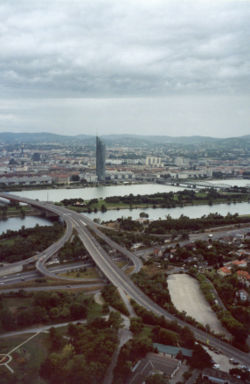
- To be translated from here
Like the train lines, Bundesstraßen leave the city in a star-shaped pattern. Some are designated after their historical final destination (Prager Straße - to Prague, Linzer Straße — to Linz, Triester Straße — to Trieste and Brünner Straße - to Brno). Bundesstraßen can be compared to Federal Highways in the United States, being two-lane in rural areas and multi-lane in urban areas.
Three national autobahns leave Vienna in the westerly ( A1), southernly (A2), and easterly directions (A4). Similar to the rail lines, they are commonly referred to after their exit direction ( Westautobahn, Südautobahn, and Ostautobahn). In addition, several spur and branch autobahns circle around the southern and eastern areas of the city. The western and northern areas were left mostly untouched because of the Wienerwald protected forest.
Air traffic
Southeast of Vienna is Vienna International Airport. In 2005, there were over 230,900 separate flights departing or arriving, and the airport was used by 15.86 million passengers. After a several year long negotiation with surrounding communities it was decided to enlarge the capacity of with the addition of a third runway. Currently the airport is undergoing a major enlargement (construction of several new buildings) to prepare for an expected increase in passengers.
Water transportation
- To be translated from here
Vienna is connected to water by the Rhine-Main-Danube Canal via the port in Rotterdam and its nearby German Industrial areas, as well as Eastern European countries up to the Black Sea. The planned Danube-Oder canal remains unfinished.
Nearly all of Vienna's drinking water is brought to the city via two large water pipelines, built in the late 19th and early 20th centuries, and stretching 120 km (75 miles) and 200 km (124 miles), respectively, from the Alps to the city's Hietzing district. The Alpine sources are pristine enough that their water does not have to be treated.
Leisure activities
Viennese parks and gardens
Vienna possesses many park facilities and is one of the greenest cities in the world. The most famous parks and green areas are the Stadtpark, the Burggarten and Volksgarten, which belong to the Hofburg, the Schloßpark of Schloss Belvedere with the Vienna Botanic Gardens, the Donaupark, the Schönbrunner Schlosspark, the Prater, the Augarten, the Rathauspark, the Lainzer Tiergarten, the Dehnepark, the Resselpark, the Votivpark, the Kurpark Oberlaa, the Auer-Welsbach-Park and the Türkenschanzpark, Laaer-Berg with the Bohemian Prater and the foothills of the Wienerwald, which reaches into the outer areas of the city. Small parks, known by the Viennese as Beserlparks, are everywhere in the inner-city areas.
Many of Vienna's famous parks include monuments, such as the Stadtpark with its statue of Johann Strauss II, and the gardens of the baroque palace, where the State Treaty was signed. The principal park of Vienna is the Prater which contains the Riesenrad, a ferris wheel. Schönbrunn, the beautiful Imperial Summer Palace, has an 18th century park which includes the world's oldest zoo, founded in 1752.
Sport
Vienna has become a popular host of many different sporting events including the Vienna City Marathon, which attracts more than 10,000 participants every year and normally takes place in May. In 2005 the Ice Hockey World Championships took place in Austria, the final was played in Vienna. After already being the stage of four Champions League (originally European Champion Clubs' Cup) finals ( 1964, 1987, 1990, 1995) the final of Euro 2008, the European Football Championships, will take place in Vienna's Ernst Happel Stadium.
Austria's capital is also the home of numerous sports teams. The best known of them are the local football clubs SK Rapid Wien (31 time Austrian national champions), FK Austria Wien (23 time Austrian national champions and record 25-time cup-winners) and the oldest of all, First Vienna FC. Important other sport clubs are the Chrysler Vikings Vienna (American Football), who won the Eurobowl title as Europe's best American Football team in 2004, the Vienna Hot Volleys, one of Europe's premier Volleyball-organisations, and the Vienna Capitals ( Ice Hockey). Vienna submitted a bid for the 1964 Olympic Games.
Culinary specialities
Food
In winter small stands on bustling street corners sell hot chestnuts and potato fritters. Sausages are also well loved and available almost everywhere. The sausage known in the USA and Germany as Wiener (German for "Viennese") is called a Frankfurter here. However other varieties are more popular at Vienna's sausage stands, such as Burenwurst, a coarse, usually boiled, beef and pork sausage or Käsekrainer, spicy pork with small chunks of cheese within it. Hot dogs are also very common, whereas due to regional food legislation the Bosner or Bosna as the Austrian equivalent of a hot dog (filled with a fried Bratwurst sausage, onions and spices) can seldom be found at the typical Viennese Würstelstand.
Vienna is also well known for Wiener schnitzel, a cutlet of veal that is pounded flat, coated in flour, egg and breadcrumbs and fried in clarified butter. It is available in almost every eatery that serves Viennese cuisine. Other examples of Viennese cuisine include "Tafelspitz" (very lean boiled beef), which is traditionally served with "Gerösteten Kartoffeln" (boiled potatoes mashed with a fork and subsequently fried), "Apfelkren" (a mixture of horseradish, cream and apple) and "Schnittlauchsauce" (a "sauce of chives" based on mayonnaise and old bread).
Vienna has a long tradition of cakes and desserts. These include Apfelstrudel (hot apple strudel), Palatschinken (sweet pancakes), and Knödel (dumplings) often filled with fruit such as apricots (Marillenknödel). Sachertorte, a chocolate cake from the Sacher Hotel, is world famous.
The Naschmarkt is a permanent market for fruit, vegetables, spices, fish, meat and much more. The city centre has many specialty food stores, such as those part of the Julius Meinl chain.
Drink
Vienna is the world's only capital city with its own vineyards (although Paris also retains a single vineyard). The wine is served in small Viennese pubs known as Heuriger, which are especially numerous in the wine growing areas of Döbling ( Grinzing, Neustift am Walde, Nußdorf, Salmannsdorf, Sievering) and Floridsdorf ( Stammersdorf, Strebersdorf). The wine is often drunk as a spritzer ("G'spritzter") with sparkling water. The Grüner Veltliner, a white wine, is the most widely cultivated wine in Austria.
Beer is next in importance to wine. Vienna has a single large brewery, Ottakringer, and more than ten microbreweries. A "Beisl" is a typical small Austrian pub, of which Vienna has many.
Viennese cafés
Viennese cafés have an extremely long and distinguished history that dates back centuries, and the caffeine addictions of some famous historical patrons of the oldest are something of a local legend. Traditionally, the coffee comes with a glass of water.Viennese cafés claim to have invented the process of filtering coffee from the captured baggage after the second Turkish siege in 1683. Viennese cafés claim that when the invading Turks left Vienna that year, they abandoned hundreds of sacks of coffee beans. The Emperor gave Franz George Kolschitzky some of this coffee as a reward for providing information that allowed the Austrians to defeat the Turks. Kolschitzky then opened Vienna's first coffee shop.
Tourist attractions
The major tourist attractions include the imperial palaces of the Hofburg and Schönbrunn (which is also the location of the world's first zoo, Tiergarten Schönbrunn), along with a number of art galleries (including the Albertina, Belvedere, Museumsquartier, KunstHausWien and BA-CA Kunstforum). The views from the Riesenrad ( ferris wheel), and the Donauturm also attract large numbers of visitors, as do several museums, including the museums in the Hofburg, the twin Kunsthistorisches Museum and Naturhistorisches Museum and the Technisches Museum. Each of these attractions receives more than 250,000 visits per year . Sites associated with the many composers who lived in Vienna have become sites of pilgrimage, such as Beethoven's various residences and St. Marx cemetery, Mozart's final resting place. Vienna's many fine churches also draw large crowds, the most famous of which are the Deutschordenskirche, the Jesuitenkirche, the Karlskirche, the Peterskirche, Maria am Gestade, the Minoritenkirche, the Ruprechtskirche, St. Stephen's Cathedral, the Schottenkirche and the Votivkirche. More modern attractions are also present, in the form of the Gasometer, Millennium Tower, Karl-Marx-Hof, Hundertwasserhaus and UNO-City. Cultural highlights include the Burgtheater and the Wiener Staatsoper, the Lipizzaner horses of the Spanish Riding School and the Vienna Boys' Choir.
International organisations in Vienna
Vienna is the seat of a number of United Nations offices and various international institutions and companies, including the United Nations Industrial Development Organization (UNIDO), the Organization of Petroleum Exporting Countries (OPEC), the International Atomic Energy Agency (IAEA), the Preparatory Commission for the Comprehensive Nuclear-Test-Ban Treaty Organization (CTBTO) and the Organization for Security and Co-operation in Europe (OSCE). Furthermore, the 1980 Diplomatic Conference was held in Vienna that led to the adoption of the United Nations Convention of Contracts for the International Sale of Goods. Additionally, Vienna is the seat of the United Nations Commission on International Trade Law's secretariat (UNCITRAL).
Charitable organisations in Vienna
Alongside the international and intergovernmental organisations, there are dozens of charitable organisations based in Vienna; these organisations provide relief goods and assistance to tens of thousands of disadvantaged children and needy people in developing countries.
One such organisation is the network of SOS Children's Villages, founded by Hermann Gmeiner in 1949. Today, SOS Children's Villages are active in 132 countries and territories worldwide. Others include HASCO and the Childrens Bridge of Hope.
Twin cities
Vienna is twinned with the following cities:
 Belgrade, Serbia (since 2003)
Belgrade, Serbia (since 2003) Bratislava, Slovakia
Bratislava, Slovakia Budapest, Hungary
Budapest, Hungary Ljubljana, Slovenia
Ljubljana, Slovenia Tel Aviv, Israel (since 2005)
Tel Aviv, Israel (since 2005) Warsaw, Poland
Warsaw, Poland Zagreb, Croatia
Zagreb, Croatia Kiev (Kyiv), Ukraine
Kiev (Kyiv), Ukraine
In addition, individual Viennese districts are twinned with Japanese cities/ districts:
- Alsergrund with Takarazuka, Hyogo. Since 1994.
- Döbling with Setagaya, Tokyo. Since 1985.
- Donaustadt with Arakawa, Tokyo. Since 1996.
- Floridsdorf (with Katsushika, Tokyo. Since 1987
- Hernals with Fuchu, Tokyo. Since 1992.
- Hietzing with Habikino, Osaka. Since 1995.
- Innere Stadt with Taito, Tokyo. Since 1989.
- Meidling with Gifu, Gifu. Since 1992.
